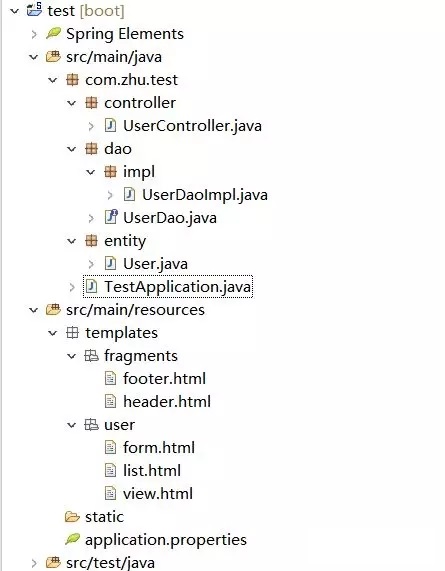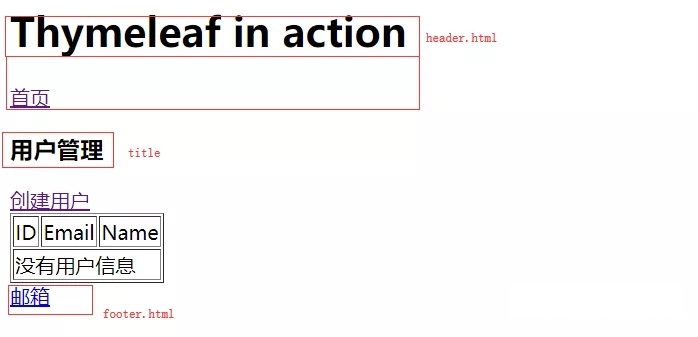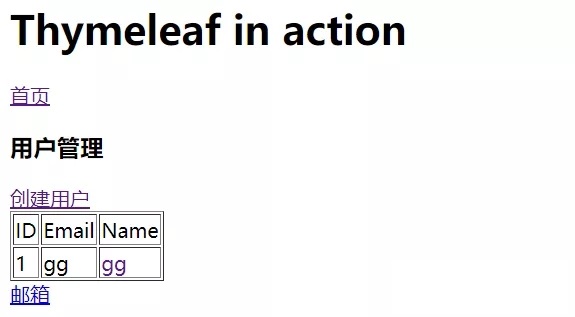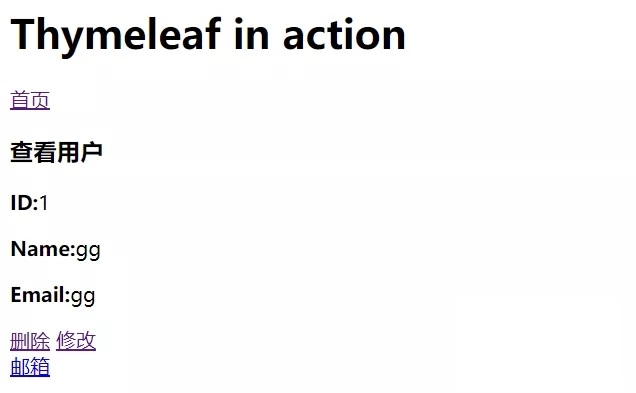thymeleaf的使用
| 编辑推荐: |
| 本文来自于微信,本文主要介绍了thymeleaf究竟是什么,spring为什么推荐用它,希望对您能有所帮助。 |
一、thymeleaf简介:
thymeleaf是一种Java模板引擎,那何为模板引擎呢?模板引擎就是为了使用户页面和业务数据相互分离而出现的, 将从后台返回的数据生成特定的格式的文档,这里说的特定格式一般都指HTML文档。它能够处理html、xml、js、css甚至纯文本,类似于freemarker。它的优点是语法优雅易懂、原型即页面、遵从web标准。原型即页面是它的特色,所谓原型即页面,就是你写的html,静态的去访问是什么样,动态的去访问还是这样,只不过动态的时候会把数据填充进去。
二、thymeleaf标准方言:
1、变量表达式:${...}例如前端接收一个user,想取出user的name属性,就可以用变量表达式:
2、消息表达式:#{...}也称为文本外部化、国际化或i18n.
3、选择表达式:*{...}与变量表达式的区别:选择表达式是在当前选择的对象上执行而不是整个上下文。
<input type = "hidden" name = "id" th:value = "*{id}" >
</form>
这里id就用了选择表达式,在此处 *{id}与 ${userModel.user.id}效果一样。
4、链接表达式:@{...}url可以是相对的,也可以是绝对的。
<a th:href="@{http://www.baidu.com}">...</a>
5、分段表达式:th:insert 、th:replace 、th:include就相当插入。这三个的区别: 现有一个片段如下:
<h1>Hello Thymeleaf </h1>
</footer>
#号分别代表insert、replace、include进行操作:
th:insert 的结果:
<footer th:fragment="copy">
<h1>Hello Thymeleaf </h1>
</footer>
</div>
把footer标签插入到了div标签中。
th:replace的结果:
<h1>Hello Thymeleaf </h1>
</footer>
把div标签换成了footer标签。
th:include的结果:
<h1>Hello Thymeleaf </h1>
<div>
把div标签里面的内容换成了footer标签里面的内容。3.X版本后不再推荐使用。
6、字面量:字面量可以是文本、数字、布尔和null等类型。
7、算术操作:+、-、*、/、%例如:
8、其他运算符:比较: >、>、/、、=、/<= (gt、lt、ge、le)等价: ==、!= (eq、ne)三目运算符:
9、迭代器:th:each相当于Java的foreach.
<td th:text="${user.id}"></td>
<td th:text="${user.email}"></td>
</tr>
这样就是遍历userList集合。
迭代器的状态变量有:index、count、size、current、even/odd、first、last
10、条件语句:th:if、th:unless、switch
<p th:case=" 'admin' ">User is admin</p>
<p th:case=" 'guest' ">User is guest</p>
</div>
11、模板布局:th:fragment比如定义一个公用的页头:
<h1>Thymeleaf in action</h1>
<a href="/users">首页</a>
</div>
在其他页面直接这样引用就行:
12、表达式基本对象:表达式基本对象有:param、session、application、request、servletContext。
三、thymeleaf与springboot集成案例:
本案例使用gradle构建,未涉及数据库,数据保存在ConcurrentMap中。未曾了解gradle的老铁可以参考一下gradle的使用。点我下载本案例源码。项目结构如下:

1、添加依赖:
compile('org.springframework. boot:spring-boot-starter-web')
testCompile('org.springframework.boot: spring-boot-starter-test' )
//thymeleaf的依赖
compile ('org.springframework.boot:spring-boot-starter-thymeleaf')
}
2、application.properties:
spring.thymeleaf.encoding=UTF-8
spring.thymeleaf.cache=false
spring.thymeleaf.mode=HTML5
3、entity层:
private Long id;
private Stringname;
private String email;
}
4、dao层:
import java . util . List ;
import java . util . concurrent . ConcurrentHashMap ;
import java . util . concurrent . ConcurrentMap ;
import java . util . concurrent . atomic . AtomicLong ;
import org . springframework . stereotype . Repository ;
import com . zhu . test . dao . UserDao ;
import com . zhu . test . entity . User ;
/**
* user dao层实现
* @author zhu
*
*/
@Repository
public class UserDaoImpl implements UserDao {
//用来计数的
private static AtomicLong counter = new AtomicLong ();
// 用来保存user的map
private final ConcurrentMap < Long , User > userMap = new ConcurrentHashMap <>();
@Override
public User saveOrUpdateUser ( User user ) {
Long id = user . getId ();
if ( id == null ) { //save
id = counter . incrementAndGet ();
user . setId ( id );
}
this . userMap . put ( id , user );
return user ;
}
@Override
public void deleteUser ( Long id ) {
this . userMap . remove ( id );
}
@Override
public User getUserById ( Long id ) {
return this . userMap . get ( id );
}
@Override
public List < User > listUsers () {
return new ArrayList < User >( this . userMap . values ());
}
}
将user保存在ConcurrentMap中,crud操作其实都是对这个map进行操作。
5、controller层:
@RequestMapping ( "/users" )
public class UserController {
@Autowired
private UserDao userDao ;
/**
* 查询所有用户
*
* @param model
* @return
*/
@GetMapping
public ModelAndView list ( Model model ) {
model . addAttribute ( "userList" , userDao . listUsers ());
model . addAttribute ( "title" , "用户管理" );
return new ModelAndView ( "user/list" , "userModel" , model );
}
/**
* 根据id查询用户
*
* @param id
* @param model
* @return
*/
@GetMapping ( "{id}" )
public ModelAndView view ( @PathVariable ( "id" ) Long id , Model model ) {
User user = userDao . getUserById ( id );
model . addAttribute ( "user" , user );
model . addAttribute ( "title" , "查看用户" );
return new ModelAndView ( "user/view" , "userModel" , model );
}
/**
* 获取创建表单页面
*
* @param model
* @return
*/
@GetMapping ( "/form" )
public ModelAndView createForm ( Model model ) {
model . addAttribute ( "user" , new User ());
model . addAttribute ( "title" , "创建用户" );
return new ModelAndView ( "user/form" , "userModel" , model );
}
/**
* 保存或更新用户
*
* @param user
* @return
*/
@PostMapping
public ModelAndView saveOrUpdateUser ( User user ) {
user = userDao . saveOrUpdateUser ( user );
return new ModelAndView ( "redirect:/users" );
}
/**
* 删除用户
*
* @param id
* @return
*/
@GetMapping ( "/delete/{id}" )
public ModelAndView delete ( @PathVariable ( "id" ) Long id ) {
userDao . deleteUser ( id );
return new ModelAndView ( "redirect:/users" ); // 重定向到list页面
}
/**
* 获取修改用户的界面
*
* @param id
* @param model
* @return
*/
@GetMapping ( "/modify/{id}" )
public ModelAndView modify ( @PathVariable ( "id" ) Long id , Model model ) {
User user = userDao . getUserById ( id );
model . addAttribute ( "user" , user );
model . addAttribute ( "title" , "修改用户" );
return new ModelAndView ( "user/form" , "userModel" , model );
}
}
6、前端页面:注意:要使用thymeleaf,需要在html标签中加上
xmlns : layout = "http://www.ultraq.net.nz/thymeleaf/layout"
如下页面:页头:header.html
<html xmlns:th = "http://www.thymeleaf.org"
xmlns:layout = "http://www.ultraq.net.nz/thymeleaf/layout" >
<head>
<meta charset = "UTF-8" >
<title> thymeleaf in action </title>
</head>
<body>
<div th:fragment = "header" >
<h1> Thymeleaf in action </h1>
<a href = "/users" > 首页 </a>
</div>
</body>
</html>
页脚:footer.html
<html xmlns:th = "http://www.thymeleaf.org"
xmlns:layout = "http://www.ultraq.net.nz/thymeleaf/layout" >
<head>
<meta charset = "UTF-8" >
<title> thymeleaf in action </title>
</head>
<body>
<div th:fragment = "footer" >
<a href = "#" > 邮箱 </a>
</div>
</body>
</html>
form.html:
<html xmlns:th = "http://www.thymeleaf.org"
xmlns:layout = "http://www.ultraq.net.nz/thymeleaf/layout" >
<head>
<meta charset = "UTF-8" >
<title> thymeleaf in action </title>
</head>
<body>
<div th:replace = "~{fragments/header :: header}" ></div>
<h3 th:text = "${userModel.title}" > test </h3>
<form action = "/users" th:action = "@{/users}" method = "POST" th:object = "${userModel.user}" >
<input type = "hidden" name = "id" th:value = "*{id}" >
名称: <br>
<input type = "text" name = "name" th:value = "*{name}" ><br>
邮箱: <br>
<input type = "text" name = "email" th:value = "*{email}" >
<input type = "submit" value = "提交" >
</form>
<div th:replace = "~{fragments/footer :: footer}" ></div>
</body>
</html>
list.html:
<html xmlns:th = "http://www.thymeleaf.org"
xmlns:layout = "http://www.ultraq.net.nz/thymeleaf/layout" >
<head>
<meta charset = "UTF-8" >
<title> thymeleaf in action </title>
</head>
<body>
<!-- 引用头部信息 -->
<!-- 在fragments下的header文件下有名为header的片段 -->
<div th:replace = "~{fragments/header :: header}" ></div>
<h3 th:text = "${userModel.title}" ></h3>
<div>
<a href = "/users/form.html" th:href = "@{/users/form}" > 创建用户 </a>
</div>
<table border = "1" >
<thead>
<tr>
<td> ID </td>
<td> Email </td>
<td> Name </td>
</tr>
</thead>
<tbody>
<tr th:if = "${userModel.userList.size()} eq 0" >
<td colspan = "3" > 没有用户信息 </td>
</tr>
<tr th:each = "user : ${userModel.userList}" >
<td th:text = "${user.id}" ></td>
<td th:text = "${user.email}" ></td>
<td ><a th:href = "@{'/users/'+${user.id}}" th:text = "${user.name}" ></a></td>
</tr>
</tbody>
</table>
<div th:replace = "~{fragments/footer :: footer}" ></div>
</body>
</html>
view.html:
<html xmlns:th = "http://www.thymeleaf.org"
xmlns:layout = "http://www.ultraq.net.nz/thymeleaf/layout" >
<head>
<meta charset = "UTF-8" >
<title> thymeleaf in action </title>
</head>
<body>
<div th:replace = "~{fragments/header :: header}" ></div>
<h3 th:text = "${userModel.title}" > test </h3>
<div>
<p><strong> ID: </strong><span th:text = "${userModel.user.id}" ></span></p>
<p><strong> Name: </strong><span th:text = "${userModel.user.name}" ></span></p>
<p><strong> Email: </strong><span th:text = "${userModel.user.email}" ></span></p>
</div>
<div>
<a th:href = "@{'/users/delete/'+${userModel.user.id}}" > 删除 </a>
<a th:href = "@{'/users/modify/'+${userModel.user.id}}" > 修改 </a>
</div>
<div th:replace = "~{fragments/footer :: footer}" ></div>
</body>
</html>
以上页面就涉及到了thymeleaf的常用标签,通过这几个页面,理解thymeleaf的用法。
7、测试效果:

点击“创建用户”:

点击“提交”后:

点击name栏可以进入view页面:

总结:
thymeleaf标签看起来很多,其实常用的也不多,且很好理解。 主要别忘了在html标签中需要加上 xmlns:th= "http://www.thymeleaf.org"xmlns:layout= "http://www.ultraq.net.nz/thymeleaf/layout"。
如果eclipse写thymeleaf标签时没有提示,安装一下thymeleaf插件重启eclipse即可, 点击 help-->installnewsoftware,地址为: http://www.thymeleaf.org/eclipse-plugin-update-site/.
- 本文标签: 数据库 MQ HTML5 java 总结 ip Action UI HashMap XML 源码 删除 tar IO 管理 2019 spring final servlet Freemarker 安装 springboot 遍历 测试 http cache CSS ArrayList 插件 mail Atom map id HTML web entity js plugin IDE session list eclipse 下载 cat 希望 App update src https ORM 数据 ConcurrentHashMap value tab ACE
- 版权声明: 本文为互联网转载文章,出处已在文章中说明(部分除外)。如果侵权,请联系本站长删除,谢谢。
- 本文海报: 生成海报一 生成海报二











![[HBLOG]公众号](https://www.liuhaihua.cn/img/qrcode_gzh.jpg)

